
Sir Edwin Landseer Lutyens was an English architect known for imaginatively adapting traditional architectural styles to the requirements of his era. He designed many English country houses, war memorials and public buildings. In his biography, the writer Christopher Hussey wrote, "In his lifetime (Lutyens) was widely held to be our greatest architect since Wren if not, as many maintained, his superior". The architectural historian Gavin Stamp described him as "surely the greatest British architect of the twentieth century".
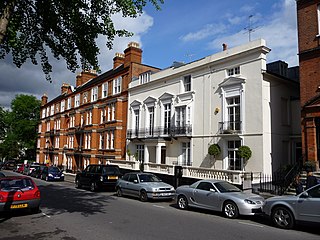
Hampstead is an area in north London, England. Lying 4 miles (6.4 km) northwest of Charing Cross, it extends from the A5 road to Hampstead Heath, a large, hilly expanse of parkland. The area forms the northwest part of the London Borough of Camden.

Hampstead Heath is a large, ancient London heath, covering 320 hectares. This grassy public space sits astride a sandy ridge, one of the highest points in London, running from Hampstead to Highgate, which rests on a band of London Clay. The heath is rambling and hilly, embracing ponds, recent and ancient woodlands, a lido, playgrounds, and a training track, and it adjoins the former stately home of Kenwood House and its estate. The south-east part of the heath is Parliament Hill, from which the view over London is protected by law.
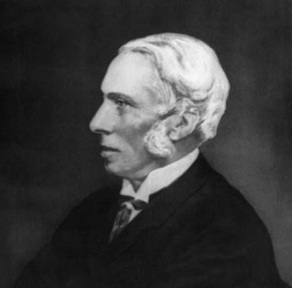
Richard Norman Shaw RA, sometimes known as Norman Shaw, was a British architect who worked from the 1870s to the 1900s, known for his country houses and for commercial buildings. He is considered to be among the greatest of British architects; his influence on architectural style was strongest in the 1880s and 1890s.

West Hampstead is an area in the London Borough of Camden in north-west London. Mainly defined by the railway stations of the same name, it is situated between Childs Hill to the north, Frognal and Hampstead to the north-east, Swiss Cottage to the east, South Hampstead to the south-east, Kilburn to the west and south-west, and Cricklewood to the north-west. The area is mainly residential with several small shops, restaurants, cafes, bakeries concentrated on the northern section of West End Lane and around West End Green. It is served by three stations: West Hampstead on the Jubilee line, West Hampstead Overground station and West Hampstead Thameslink station. It is part of the Kilburn postal district (NW6).

Kenwood House is a former stately home in Hampstead, London, on the northern boundary of Hampstead Heath. The house was originally constructed in the 17th century and served as a residence for the Earls of Mansfield during the 18th and 19th centuries.
Samuel Sanders Teulon was a 19th-century English Gothic Revival architect, noted for his use of polychrome brickwork and the complex planning of his buildings.

The Spaniards Inn is an historic pub on Spaniards Road between Hampstead and Highgate in London, England. It lies on the edge of Hampstead Heath near Kenwood House. It is a Grade II listed building, dating back to the 16th century.

The Free Church is a building located in Hampstead Garden Suburb, Barnet, London. It was built to a design by Sir Edwin Lutyens starting in 1911, and, like St Jude's Church at the opposite side of Central Square, is a Grade I listed building.

Frognal is a small area of Hampstead, North West London in the London Borough of Camden. Frognal is reinforced as the name of a minor road, which goes uphill from Finchley Road and at its upper end is in the west of Hampstead village.
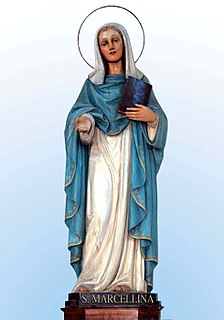
Saint Marcellina was born in Trier, Gaul the daughter of the Praetorian prefect of Gaul, and was the older sister of Saint Ambrose of Milan. She devoted her life to the practice of prayer and asceticism. Her feast day is July 17.

St Mary's Church, formerly St Mary's Chapel, is a Grade II* listed Roman Catholic church in Hampstead, London, UK.
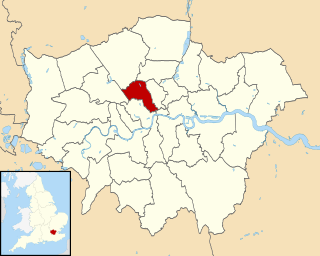
The London Borough of Camden is a borough in Inner London and, for the purposes of the London Plan has been designated as part of 'Central London'. Camden was historically a part of Middlesex. Camden Town Hall, on Euston Road, lies 1.4 mi (2.3 km) north of Charing Cross. The borough comprises a central area stretching south of Euston Road almost all the way to the Thames at Lincoln's Inn Fields, including parts of the West End of London with its numerous theatres and cultural institutions, and a north-western part north of Euston Road stretching to Hampstead and Highgate.

Sarum Chase is a large detached neo-Tudor mansion, at 23 West Heath Road, Hampstead, London, described by Nicholas Pevsner as "pure Hollywood Tudor".
There are over 9,000 Grade I listed buildings and 20,000 Grade II* listed buildings in England. This page is a list of these buildings in the London Borough of Barnet.
Horace Field was a London-born architect. His work was often in a Wrenaissance style, as well as other post-gothic English historical revival styles, with influences from the Arts and Crafts movement and Richard Norman Shaw. His commissions including large houses and offices; he produced a number of works for Lloyds Bank as well as offices for the North Eastern Railway in London and York.
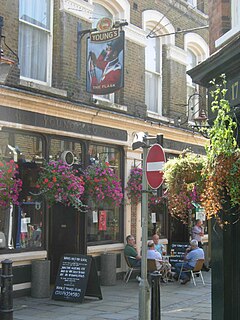
The Flask is a Grade II listed public house at 14 Flask Walk, Hampstead, London, on the site from where the trade in Hampstead mineral water was run, and which is mentioned in the eighteenth century novel Clarissa. It has been owned by Young's Brewery since 1904.

St John's Downshire Hill, Hampstead is a proprietary chapel of the Church of England, located in Downshire Hill, Hampstead, London, in the Parish of St Stephen with All Hallows. Referred to as St John's Church, the building was formally a chapel. The church should not be confused with St John-at-Hampstead, which is located in Church Row, Hampstead being the parish church of what is now the neighbouring parish.

Hampstead Road is a road in London, England, stretching over a kilometre between Bloomsbury and Camden Town. It is signed as the A400. Hampstead Road terminates at Euston Road in the south, where it continues as Tottenham Court Road and Gower Street. In the north, at Mornington Crescent, Hampstead Road becomes Camden High Street.

















